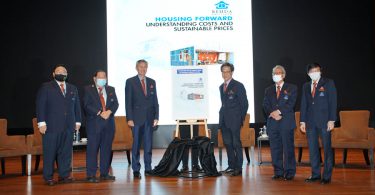Many might know him by his popular handle Boss Mewah, but regardless of how one knows him, AJ Chin is certainly a dynamic force to be reckoned with. Having been contributing substantially to Malaysia’s construction industry for the past 20 years, it is clear that he also embodies a spirit of passing on knowledge, expertise and skills. Aside from being Co-founder of Connecteam Sdn Bhd, a company focusing on specialised projects that cover renovations to new building construction, AJ is an author and mentor, teaching and training the next generation of construction professionals, as well as advising for the Industry Advisory Panel for Petronas University of Technology to bridge the gap between educational offerings and industry demands.
Wanting to know more about the upfront contractor boss behind the DIY social media clips, Construction Plus Asia sat down with AJ to learn more about what it takes to become a thriving contractor in this increasingly competitive building landscape.
You wear many hats in the construction business. How did they all collectively help you to become a better contractor?
In Malaysia, contractors in general need to wear many hats, with each hat representing a crucial role in the construction industry. From my experience, contractors need to learn a diverse skill set and even excel as a human resource (HR) professional for different client segments: the T20, where the majority of our clients are; the M40, where both clients and employees are found; and the B40, where foreign workers and staff are involved. It is important to recognise that a one-size-fits-all approach cannot be applied across these different groups.

A three-storey bungalow with a swimming pool at Saujana Resort, Malaysia; all images courtesy of AJ Chin
A fundamental aspect that every contractor should possess is a strong understanding of technical elements, such as the construction process. When it comes to buildings, houses and even our homes, there are three key aspects to consider. The first aspect is the building structure itself. The second aspect is MEP, known as mechanical, electrical and plumbing. They encompass essential components that may not be visible, but they greatly impact our daily lives. If people don’t invest in MEP, it can lead to various conflicts and inconveniences, such as insufficient cooling from air-conditioning; poor water pressure for showers; inadequate hot water supply; malfunctioning light switches; and slow data and Wi-Fi connections. The third aspect to consider is architectural finishes and interior design. It is crucial to design and execute these elements to ensure durability and minimise defects.
Sometimes, as contractors, we know that certain designs or material choices may lead to potential issues in the coming three to five years. However, we cannot directly point out these flaws to the designer or architect. Instead, we need to handle this diplomatically. We may ask questions like: What if it rains and the water flows in this direction? Will these techniques create long-term issues? By raising these concerns, we indirectly prompt designers to reconsider their choices and find alternative solutions. This is why we strive to be good HR persons, effectively communicating and addressing different matters.
With the current development of construction technology, what are the main issues facing contractors today?
The primary challenge faced by contractors is the issue of leakages of money. The construction process involves many layers. Once a main contractor receives a job from a client, he must coordinate with various parties, including the client’s representatives, the architect, the designer, subcontractors, plumbers and suppliers. In the past, in the absence of suitable technology, the main contractors often find themselves having to repeat the same information to different teams and parties, resulting in persistent miscommunication issues. Time was wasted on repetitive briefings, explanations and meetings. Don’t forget that the larger the scale of the project, the more parties and individuals are involved.
A few years ago, I participated in constructing the Tenaga Nasional Berhad (TNB) power plant that supplies electricity to the Jinjiang Mass Rapid Transit (MRT) Substation in Kuala Lumpur. Upon completion, we discovered a loss of 350 cubic metres of concrete out of the total 1,350 cubic metres used—this amount of concrete lost in the process could have constructed an entire bungalow structure! During that time, technological systems capable of effectively tracking material usage or delivery were not widely prevalent. With the advancement of technology, it is now possible to monitor each bag of cement used along the way via apps like Speedbrick, or PlanRadar for project management.
However, an ongoing concern is that many contractors are not willing to invest in technology, which leads to a lack of awareness regarding leakages and the existence of potential problems. Consequently, contractors simply accept the occurrence of leakages without investigating further. They end up losing money without understanding the underlying reasons.
“The dropout rate for contractors in Malaysia is alarmingly high, with only four out of every 100 remaining in the business after 10 years. It is easy to start but significantly more challenging to sustain.”
Project Case Study
Refurbishment and Renovation of the Third and Fourth Floors of Avenue K Mall

The renovation of the third and fourth floors of Avenue K Mall located in Kuala Lumpur City Centre was completed in 2019
This project aimed to upgrade and expand the two floors to attract new tenants and set the mall apart from nearby competitors at that time, such as Suria KLCC Mall and the now defunct Robinsons Department Store at Four Seasons Place Kuala Lumpur. The construction team also needed to minimise disruption to the mall’s ongoing operations.
SUPPLY AND LOGISTICS CHALLENGES
One of the key design elements of the project was the use of a special woven steel mesh material, a feature not commonly seen in shopping malls before. However, the supplier of the tender did not have any stock and the material was also not readily available in the local market. Despite an extensive search from Qatar to Johal, the construction team was unable to find the material until they finally reached a supplier in China.

About 120 workers were employed to carry out various manual labour tasks in this project
Every construction material, from steel and cement to large construction rubble, had to be manually transported up and down the mall using the service lift in sugar bags. The lift was shared with the mall tenants and so the team had to carefully coordinate and schedule the optimal times for using the lift. Furthermore, as the mall continued its operations throughout the construction period, the team had to monitor the noise levels on a daily basis and collaborate closely with the mall’s management team to minimise disturbances for tenants and visitors.
This is an excerpt. The original article is published in
Construction+ Q2 2024 Issue: The Contractors: Integrating Expertise Across Construction.
Get the print magazine or subscribe to the digital edition to read the complete article.

 Hong Kong
Hong Kong Singapore
Singapore Indonesia
Indonesia Tiếng Việt
Tiếng Việt ประเทศไทย
ประเทศไทย









